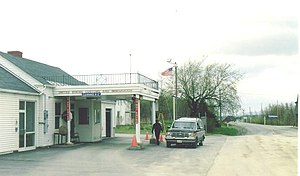Limestone–Gillespie Portage Border Crossing
| Limestone–Gillespie Portage Border Crossing | |
|---|---|
 US Border Inspection Station in Limestone, Maine as seen in 1998 | |
| Location | |
| Country | United States; Canada |
| Location | |
| Coordinates | 46°55′29″N 67°47′22″W / 46.924667°N 67.789571°W |
| Details | |
| Opened | 1929 |
| US Phone | (207) 325-4769 |
| Canadian Phone | (506) 473-3536 |
| Hours | Open 6:00 AM-10:00 PM Eastern |
| Website | |
U.S. Inspection Station-Limestone, Maine | |
| MPS | U.S. Border Inspection Stations MPS |
| NRHP reference No. | 14000556 |
| Added to NRHP | September 10, 2014 |
The Limestone–Gillespie Portage Border Crossing is an international border crossing connecting the towns of Limestone, Maine, United States, and Grand-Sault, New Brunswick, Canada. The crossing is reached by Maine State Route 229 on the American side and by New Brunswick Route 375 on the Canadian side. The United States crossing facilities are the original facilities first built for this crossing in 1933, and were listed on the National Register of Historic Places in 2014.
South of the crossing, one hundred yards from the border, is a decommissioned Nike missile base that is now an auto repair shop. It was one of four that protected nearby Loring Air Force Base.[1]
Canadian facilities
[edit]
This section needs expansion. You can help by adding to it. (July 2015) |
The Canadian government first built a border station at this crossing sometime around 1930. The current facility was built in 1984.[2]
United States facilities
[edit]
The United States border station originally included the main building and two residences, located to its rear. The residences have since been demolished. The main building is a wood frame structure, a single story in height, with a side gable roof and flanking wings, each of which house two garage bays for performing inspections, and is located quite close to the border. The building was divided inside to provide space for performing customs procedures by the USCS on one side and immigration procedures by the INS on the other.[3]
Prior to the construction of this station, customs and immigration formalities would have taken place in the nearest town. With the advent of increased automobile traffic in the 1920s, as well as the need to interdict the movement of contraband liquor due to Prohibition, the federal government realized the need for border stations where immigration formalities and vehicle inspections could be performed close to the border, and consequently planned the construction of a series of such stations. The Limestone station was authorized as part of a large authorization enacted in 1931. The federal government purchased land at the border from Walter and Hiram Phair in 1932, construction began in 1933, and the station was opened in January 1934. Although there were standardized building plans for the construction of these stations, the Limestone facilities are distinct in that they do not follow any of them. The station is similar to a "Type 2" facility, but uses less expensive construction materials.[3] The station was listed on the National Register of Historic Places for its architecture and its historical associations with the federal government's efforts to control the nation's borders.
See also
[edit]- List of Canada–United States border crossings
- National Register of Historic Places listings in Aroostook County, Maine
References
[edit]- ^ "Chapter 1: Eastern Maine". United Divide: A Linear Portrait of the USA/Canada Border. The Center for Land Use Interpretation. Winter 2015.
- ^ "Gillespie Border Crossing (CBSA)". Retrieved July 24, 2014.
- ^ a b "A Federal Presence in the Maine Countryside..." (PDF). US Customs and Border Patrol. Retrieved July 7, 2015.
- Transportation buildings and structures in Aroostook County, Maine
- Limestone, Maine
- National Register of Historic Places in Maine
- Transport in Victoria County, New Brunswick
- Buildings and structures in Victoria County, New Brunswick
- Grand Falls, New Brunswick
- National Register of Historic Places in Aroostook County, Maine
- 1929 establishments in Maine
- 1929 establishments in New Brunswick
